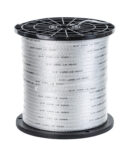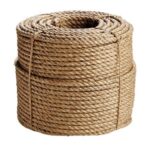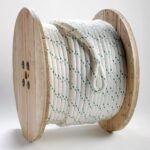How to Care for Your Rope: Get the Best Performance from Every Spool
At Erin Rope, we’re proud to manufacture high-performance, American-made rope and twine products that meet the demands of utility, industrial, marine, agricultural, and general-purpose applications. Our ropes are built to last, but proper care and handling play a crucial role in preserving their strength, extending their service life, and ensuring safety.
Regardless of the rope material or construction, the steps you take to store, inspect, and handle your rope are essential to maintaining performance in the field. In this guide, we share practical tips to help you get the most out of your Erin Rope products, based on proven best practices and our decades of industry experience.
Why Rope Maintenance Matters
Rope is a critical part of your operation, whether you’re lifting, securing, pulling, or towing. While our ropes are engineered for durability, long-term performance depends on how they’re used and maintained.
Exposure to UV rays, heat, chemicals, moisture, or mechanical abrasion can gradually degrade rope fibers. Neglecting proper care can lead to reduced working strength, compromised safety, and earlier-than-expected replacement.
By taking care of your rope, you’ll:
- Extend its usable life
- Maintain consistent performance under load
- Improve safety on job sites, vessels, or in the field
- Reduce downtime and replacement costs
Store It Right
Proper storage is the first step in rope care. Storing your rope in a clean, dry, and well-ventilated area helps protect it from environmental damage that can shorten its lifespan. Natural fiber ropes, such as manila or cotton, are particularly susceptible to moisture, whereas synthetic ropes like nylon and polyester are protected against heat and UV rays.
Storage Best Practices:
- Keep the rope off the ground and away from direct sunlight
- Store in a cool, dry place with good airflow
- Avoid contact with oil, chemicals, and corrosive materials
- Coil or spool ropes properly to prevent kinks, crushing, or flat spots
- Let wet rope dry completely before storage
Use It Correctly
Even the strongest rope can be damaged by improper use. Following basic handling guidelines helps maintain strength and prevents premature wear.
Use Guidelines:
- Never exceed the working load limit
- Avoid shock loading or sudden jerks, especially with low-stretch ropes
- Use the correct rope diameter for the job and match it to the proper hardware
- Make sure the sheave or pulley diameter is at least 8 times the rope diameter (for example, a 1″ rope should run over a sheave that’s at least 8″ in diameter)
- Use thimbles or guards at stress points to reduce wear
- Rotate rope ends regularly to distribute wear evenly
- Avoid dragging rope across abrasive surfaces or sharp edges
Following these practices helps preserve the rope’s integrity and ensures better performance over time.
Inspect It Often
We recommend inspecting your rope before, during, and after each use, especially in applications where safety is a key factor. While some signs of wear are easy to spot, others may be more subtle.
What to Look For:
- Frayed, fuzzy, or abraded fibers
- Glazed or melted spots caused by friction or overload
- Discoloration from UV exposure or chemical contact
- Hard or stiff areas indicating internal damage
- Cuts, broken strands, or noticeable thinning
If you notice any of the above, remove the rope from load-bearing use immediately. In critical applications, we also recommend keeping a written inspection log to track rope condition over time.
Know Your Rope Material
Different rope fibers perform differently, and caring for them accordingly helps maintain their strength and reliability.
Nylon: Known for high strength and elasticity. Performs well under dynamic loads, but loses strength when wet and is more sensitive to UV exposure than polyester. Avoid excessive stretching and store dry.
Polyester: Offers low stretch, high UV resistance, and excellent abrasion performance. Ideal for outdoor environments, static loads, and long-term exposure.
Natural Fiber Ropes: Require dry, well-ventilated storage to prevent rot. These ropes are biodegradable and sensitive to moisture but offer a traditional grip and handling feel.
For more details on fiber properties and use-specific recommendations, check out our Care & Use Guide.
Built to Perform. Made to Last.
We build our rope to meet high standards for strength, safety, and durability. But to get the best performance from your Erin Rope products, ongoing care is key.
By storing your rope properly, handling it with care, and conducting regular inspections, you can extend its lifespan and ensure it’s always ready to perform whenever and wherever you need it.
If you have questions about care, product selection, or usage for a specific application, we’re here to help. Reach out to our team anytime. We’re always glad to assist.



